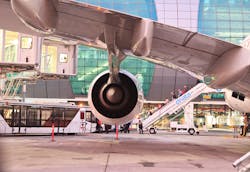Boeing forecasts $550 billion market for new airplanes in Middle East
DUBAI, U.A.E., 14 Nov. 2013. Boeing (NYSE:BA) forecasts that airlines in the Middle East will require 2,610 new airplanes over the next 20 years, worth an estimated $550 billion. While one-third of that demand – 900 airplanes – will replace today's fleets, 66 percent of the demand is expected to be driven by the rapid fleet expansion in the region.
Boeing analysts, having updated the Boeing Current Market Outlook (CMO), are forecasting that long-range, twin-aisle airplanes, such as the Boeing 777 and 787 Dreamliner, will continue to dominate the Middle East's order books.
"International traffic growth in the Middle East continues to outpace the rest of the world," says Boeing Commercial Airplanes Vice President of Marketing Randy Tinseth. "The Gulf region benefits from a unique geographic position that enables one-stop connectivity between Europe, Africa, Asia, and Australasia. Additionally, over the last decade, we've seen a rise in low-cost carriers that have benefitted from a large youthful population, large migrant workforce and trends toward market liberalization."
Twin-aisle aircraft will account for more than half of the region's new airplane deliveries over the 20-year period, as compared to 24 percent globally, according to the Boeing forecast. Single-aisle airplanes, such as the Boeing 737, will make up 47 percent of regional deliveries through 2032, while large airplanes such as the Boeing 747 will account for 10 percent of forecasted demand. Regional jets account for the remaining 1 percent of the demand.
"Boeing is well-positioned to address demand in the Middle East," Tinseth adds. "Boeing airplanes provide airlines in the region with the capability to serve their expanding networks, the comfort and flexibility for a premium brand experience and the superior operating economics to create advantages not only for the airlines, but the flying public as well."
Globally, Boeing has forecast a long-term demand for 35,280 new airplanes, valued at $4.8 trillion. These new airplanes will replace older, less efficient airplanes, benefiting airlines and passengers and stimulating growth in emerging markets and innovation in airline business models. To meet the growing demand for new airplanes, Boeing has increased production of its popular 737, 777, and 787 airplane families.
GTS Production / Shutterstock.com" target="_blank">Dubai Airport images courtesy Nadezhda1906 / Shutterstock.com" target="_blank">Shutterstock.
